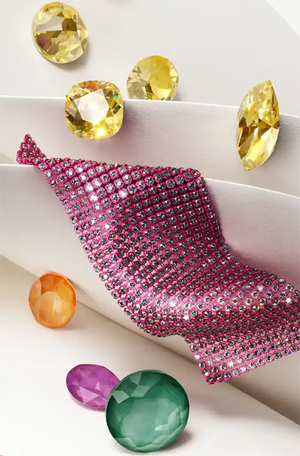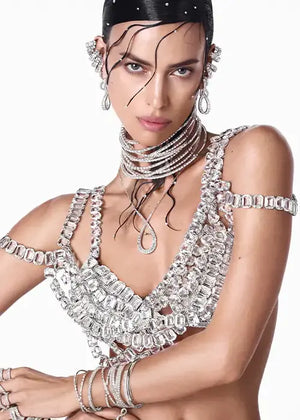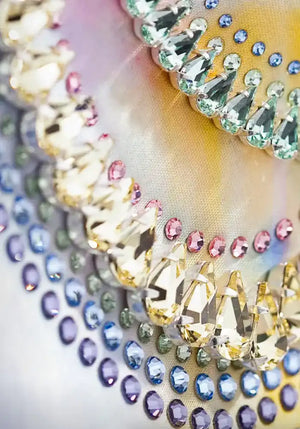
How to Attach Rhinestones on a Burlesque Costume
When you're crafting a burlesque costume, the sparkle matters just as much as the fabric and design. Rhinestones add that extra level of glamour, catching the spotlight and turning heads on stage. But with so many types and styles available, how do you know which rhinestones are right for your costume? Let’s take a look.
Types of Rhinestones
You have several options when selecting rhinestones: non-hotfix (flatback), hotfix, and sew-on. Flatback rhinestones without adhesive (non-hotfix) are commonly used in costuming because they're versatile—you attach them manually with glue, giving precise control over placement. Hotfix rhinestones have adhesive already applied, activated by heat, which is ideal for fabric-friendly applications. Sew-on rhinestones have tiny holes to stitch directly onto garments, great for areas needing extra durability.
If you're looking to explore your options further, choose the best rhinestones for your craft, and discover a world of sparkling possibilities.
Best Sizes and Shapes for Burlesque Costumes
Choosing the right sizes and shapes is essential to achieve a balanced yet eye-catching effect. Generally, a combination of sizes creates visual interest—larger rhinestones (SS30 and above) grab attention, while smaller sizes (SS12 to SS20) fill in gaps neatly. Popular shapes like round, teardrop, or navette (pointed oval) add flair, drawing attention to curves and contours of the costume.
Tools & Materials Needed for Rhinestoning
Before you dive in, make sure you've gathered all necessary tools. You'll need:
- Rhinestones (various sizes and shapes)
- Rhinestone glue (Gem-Tac or E6000 recommended)
- Wax rhinestone picker or tweezers
- Fabric chalk or washable marker for design planning
- Hotfix applicator tool (if using hotfix rhinestones)
- Needle and thread (if sewing rhinestones)
Having your tools ready before starting means fewer interruptions, smoother application, and a cleaner final look.
Best Techniques for Attaching Rhinestones
There are a few popular methods for attaching rhinestones to your burlesque costume, each offering different benefits depending on your fabric and the level of durability required.
Gluing Method (Most Common & Secure for Costumes)
Gluing is the most popular and reliable way to attach rhinestones. Apply small dots of glue directly onto your costume fabric—just enough to hold the stone without spilling out around the edges. Carefully place each rhinestone using tweezers or a wax picker, gently pressing down to secure.
Glue such as Gem-Tac dries clear, flexible, and washable, making it ideal for costumes that require frequent wear. For heavier rhinestones or costumes undergoing intense performance routines, industrial-strength glue like E6000 might offer greater security.
Hotfix Method (For Fabric-Friendly Applications)
Hotfix rhinestones come pre-coated with adhesive that activates when heated. Using a hotfix applicator tool, position the rhinestone and apply gentle heat. The adhesive melts and bonds securely to fabric fibres. This method is quick, mess-free, and ideal for sturdy fabrics like cotton, velvet, or heavy satin.
However, be cautious with delicate or synthetic fabrics that could be damaged by heat. Always test a small hidden area first.
Sewing Method (For Extra Durability on Delicate Fabrics)
For costumes made from delicate fabrics like lace or silk, sewing is the safest choice. Sew-on rhinestones offer unmatched durability and won't damage the fabric with heat or glue residue. Using a fine needle and matching thread, stitch each rhinestone securely, ensuring they remain firmly in place throughout performances.
Sewing can be more time-consuming, but it provides peace of mind for fragile or expensive materials.
Placement & Design Tips for Maximum Sparkle
Planning Your Design Before Applying
Before you start attaching rhinestones, sketch your design directly onto the fabric using fabric chalk or a washable marker. This lets you visualise placement and spacing without guesswork. Consider symmetry, shapes, and contours of the costume to highlight your figure. Strategic placement enhances movement on stage, creating stunning effects as the rhinestones catch the light.
Best Areas to Rhinestone on a Burlesque Costume
Certain areas of your burlesque costume naturally draw attention and benefit from added sparkle. Common spots include necklines, bust lines, waistbands, and hemlines. Fringe, straps, and embellishments around cuffs or collars also look stunning with rhinestones.
Placing rhinestones along curves or seams helps define shape, while scattering smaller gems across open spaces creates a sparkling gradient effect, amplifying stage presence.
Common Mistakes to Avoid
Even experienced costume-makers can run into pitfalls. Knowing what mistakes to avoid can save time and frustration, ensuring your rhinestoned costume is performance-ready.
Using Too Much Glue (Leading to a Messy Look)
One of the biggest mistakes is applying excessive glue, causing it to ooze around the rhinestones. Less is more—use just enough glue to secure the rhinestone. If glue seeps out, carefully remove excess immediately with a toothpick or damp cloth.
Choosing the Wrong Rhinestone Type for Fabric
Always match your rhinestone type with your fabric. Hotfix stones can scorch delicate fabrics, while glue methods may seep through sheer materials. Carefully evaluate your fabric before choosing your attachment method to avoid unnecessary damage.
Not Allowing Enough Drying Time Before Wearing
Impatience is tempting, but rushing the drying process can lead to rhinestones shifting or falling off. Allow a minimum of 24 hours drying time before wearing your costume—48 hours if you have the luxury. Proper drying ensures the adhesive cures fully, keeping stones securely in place.
How to Care for and Maintain Rhinestoned Costumes
Proper care ensures your rhinestones stay securely attached, dazzling audiences for performances to come. Hand-wash rhinestoned costumes gently in cold water, avoiding harsh detergents or excessive agitation. Always air-dry garments flat to avoid heat damage or stones loosening.
Store costumes flat or neatly hung to avoid bending or crushing the stones. A little extra care goes a long way, preserving your costume’s sparkle for years.
Final Thoughts
Attaching rhinestones to your burlesque costume enhances its elegance, drama, and overall impact on stage. With careful planning, thoughtful rhinestone selection, and meticulous application, your costume will shine under any spotlight.
If you want to take your design even further, you can always learn more about rhinestone colours, unlocking endless possibilities to dazzle and captivate your audience.







